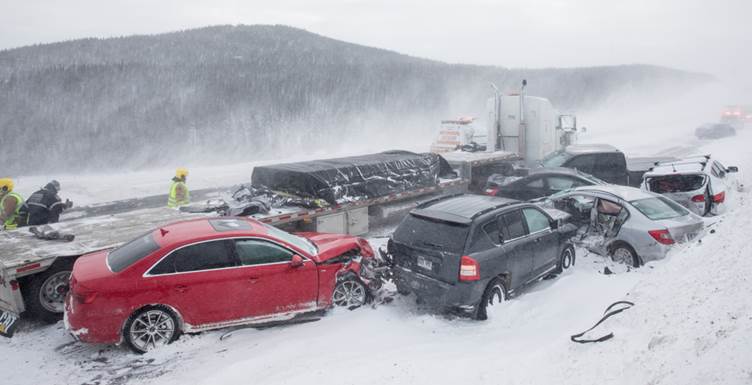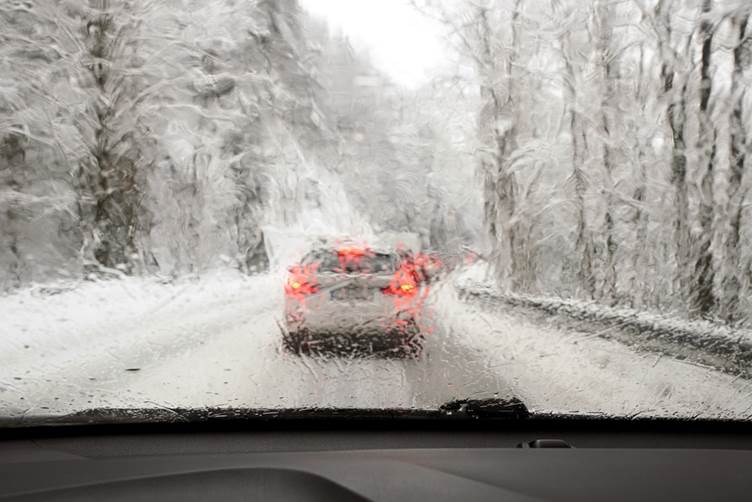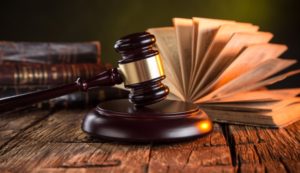
Weather conditions can be a fickle and formidable adversary for any driver on the road. As motor accident attorneys, we understand that accidents are not always black and white; external factors, such as rain, snow, fog, or icy roads, can greatly influence them. Out of nearly six million vehicular crashes annually in the United States, approximately 22% are weather-related.
When rain obscures visibility, snow turns roads treacherous, or fog blankets the landscape, driving dynamics change dramatically. As drivers, we must adjust our behaviors and techniques to adapt to these conditions, but what happens when an accident occurs despite our best efforts? How do these weather-related elements factor into the complex web of liability and claims?
Whether you’ve been involved in an accident or are simply curious about the legal implications of weather-related accidents, this exploration will provide valuable information to help you navigate this complex terrain.
So, buckle up as we venture into the world where the skies meet the roads, and discover the often surprising and sometimes confounding ways that weather conditions can impact motor accident claims.
Types of Weather-Related Accidents
Weather conditions profoundly influence driving dynamics, often leading to various types of accidents that can result in property damage, injuries, and even fatalities. Here, we’ll explore some of the most common types of weather-related accidents and their implications:
1. Rain and Hydroplaning
Rain-slicked roads can drastically reduce traction, leading to the dangerous phenomenon of hydroplaning. When a layer of water prevents your tires from maintaining contact with the road, steering, and braking control are compromised. Hydroplaning can result in loss of control, skidding, and collisions.
2. Snow and Ice-Related Accidents
Snow and ice can turn roads into hazardous ice rinks. Icy roads lead to increased braking distances, difficulty in steering, and a heightened risk of spin-outs and collisions. Snow accumulation can further obscure road markings and create treacherous driving conditions. About 76,000 people get injured in traffic accidents during sleet or snowfall each year.
3. Fog-Induced Reduced Visibility
Fog drastically reduces visibility, making it challenging for drivers to anticipate obstacles, changes in traffic flow, or upcoming turns. Reduced visibility increases the risk of rear-end collisions, sideswipes, and intersection accidents.
4. Glare from Sunlight
While not often associated with adverse weather, sun glare can create blinding conditions for drivers, making it difficult to see the road and other vehicles. This can result in accidents due to delayed reactions or misjudgment of distances.
5. Wind and Reduced Vehicle Stability
Strong crosswinds, especially in open areas or on bridges, can affect the stability of vehicles, leading to swerving or even tipping over. Drivers might find it challenging to maintain control of their vehicles, especially larger ones like trucks and trailers.
6. Hail and Debris Hazards
Hail can create slick road surfaces and obstruct visibility. Additionally, severe weather might lead to debris on the road, increasing the risk of accidents as drivers swerve to avoid obstacles.
Understanding these different types of weather-related accidents is crucial for preventing them and for assessing liability, and pursuing claims when they do occur.
Establishing Liability in Weather-Related Accidents
Determining liability in motor accidents involving adverse weather conditions can be more complex than it appears. While weather-related accidents might seem like acts of nature, the legal principles of negligence and duty of care still apply. Here’s how liability is established in these situations:
1. Standard Duty of Care
Drivers are generally expected to exercise reasonable care under normal driving conditions. However, adverse weather conditions demand a higher level of caution and adaptation. Failing to adjust driving behavior to account for rain, snow, fog, or other weather-related factors can constitute negligence.
2. Shared Responsibility
In some cases, both drivers involved in an accident might share the blame due to their failure to adjust to the weather conditions. Shared responsibility might result in a more complex claims process, as each party’s contribution to the accident must be assessed.
3. Legal Adherence to Road Conditions
Drivers should adhere to the laws and regulations applicable to road conditions. This might mean reducing speed, increasing following distance, and using headlights in low-visibility situations. Failure to follow these laws can establish negligence.
4. Unforeseeable Circumstances
Accidents might occur in certain extreme weather situations despite a driver’s utmost caution. Legal precedent often considers whether the accident was foreseeable given the weather conditions. The driver might have a stronger defense if the conditions were particularly severe.
5. Professional Drivers and Higher Standards
Commercial drivers, such as truck drivers, might be held to a higher standard due to their experience and training. They are expected to exercise additional caution in adverse weather conditions, and their failure to do so can result in liability.
6. Use of Expert Testimony
In weather-related accident claims, the testimony of meteorological and accident reconstruction experts can be pivotal. Experts can help establish a link between the weather conditions and the accident, helping to prove causation and liability.
When pursuing a claim in a weather-related accident, working with an experienced motor accident attorney who understands the legal nuances involved is important.
Evidence Collection and Documentation
[image: Shutterstock]
Solid evidence and thorough documentation are invaluable assets for establishing liability and building a strong case in weather-related motor accident claims. Here’s a comprehensive guide to collecting and preserving crucial evidence:
1. Immediate Action
After a weather-related accident, prioritize safety and seek medical attention if necessary. Once it’s safe to do so, move vehicles to a secure location, especially in situations where low visibility poses additional risks.
2. Document Weather Conditions
Take photographs or videos of the weather conditions at the time of the accident. Capture any rain, snow, fog, or other relevant conditions that could have contributed to the accident. These visual records provide essential context for your case.
3. Record Accident Details
Note down essential details such as the date, time, location, road conditions, and the specific weather conditions prevailing at the time of the accident. Also, include special conditions like reduced visibility due to fog or slick roads due to rain or ice.
4. Witness Statements
If there are witnesses to the accident, collect their contact information and statements about what they observed. Witnesses can provide unbiased accounts of the events, helping to corroborate your version of the accident.
5. Police Reports
If law enforcement arrives at the scene, ensure they document the accident and the prevailing weather conditions in their report. Obtain a copy of the police report, as it can serve as an official record of the incident.
6. Vehicle Damage Documentation
Take detailed photographs of the damage sustained by all vehicles involved. If the weather conditions caused or exacerbated the collision, these images can help illustrate the extent of the impact.
7. Dashcam Footage
If you have a dashcam installed in your vehicle, the footage could provide valuable evidence of the accident’s sequence and the weather conditions at the time. This can be a powerful tool in establishing fault.
8. Medical Records
If you sustained injuries due to the accident, ensure you seek medical attention promptly. Keep all medical records, including doctor’s assessments, treatment plans, and any follow-up appointments. These documents link your injuries to the accident.
9. Accident Reconstruction Experts
Consider involving accident reconstruction experts who can use the available evidence to recreate the accident and demonstrate how the weather conditions contributed to the incident.
10. Communication Records
If you communicated with the other driver, witnesses, or emergency services, retain records of these interactions. Text messages, emails, or calls might contain valuable information about the accident and prevailing weather conditions.
By meticulously collecting and documenting evidence, you provide your motor accident attorney with the necessary tools to advocate on your behalf. Weather-related accidents often demand comprehensive documentation to effectively establish the connection between adverse conditions and the accident itself.
Role of Expert Witnesses
Weather-related motor accident claims often require a deeper analysis to establish the correlation between adverse weather conditions and the accident’s occurrence. Expert witnesses are crucial in providing technical insights that can strengthen your case. Here’s how their expertise comes into play:
1. Meteorological Experts
Meteorological experts are trained to interpret weather data and conditions at the time of the accident. They can provide detailed insights into factors such as visibility, road surface conditions, precipitation rates, and wind speeds. Their testimony helps establish how weather conditions directly influenced the accident.
2. Accident Reconstruction Experts
Accident reconstruction experts use scientific principles and evidence to recreate the accident sequence. Weather-related claims focus on how factors like reduced visibility, slick roads, or strong winds contributed to the collision. Their analysis aids in clarifying the cause-and-effect relationship.
3. Causation and Liability Clarification
Expert witnesses help bridge the gap between adverse weather conditions and the accident’s occurrence. Explaining how specific weather elements influenced the events leading to the accident establishes a clear causation link vital for proving liability.
4. Counteracting Insurance Company Arguments
Insurance companies may try to downplay the impact of weather conditions or attribute the accident solely to driver negligence. Expert witnesses counter these arguments with data-driven analyses, demonstrating the weather’s significant role in the accident.
5. Building a Persuasive Case
Expert testimony adds credibility to your case, especially when explaining complex meteorological or technical concepts to the judge and jury. Their opinions are based on scientific principles and unbiased observations, enhancing the persuasive power of your claim.
6. Negotiating with Insurance Companies
Expert witnesses can provide a compelling basis for your claim’s value when dealing with insurance companies. Their professional opinions can sway insurers to acknowledge the weather’s role and offer a fair settlement rather than dismissing your claim.
7. Testifying in Court
Expert witnesses can present their findings and opinions under oath if your case goes to court. Their testimony can be instrumental in demonstrating the link between weather conditions and the accident, aiding the judge and jury in understanding the complexities of the case.
Engaging expert witnesses requires collaboration with your motor accident attorney. They will identify the right experts, coordinate their involvement, and effectively integrate their insights into your case strategy.
Insurance Company Challenges
[Image: Shutterstock]
Dealing with insurance companies in weather-related motor accident claims can be daunting. These companies often attempt to minimize payouts by attributing accidents solely to adverse weather conditions or shifting the blame onto the involved parties. Here are the challenges you might encounter and strategies to navigate them effectively:
1. Weather as the Sole Cause
Insurance adjusters may assert that adverse weather conditions were the primary cause of the accident, thus absolving their policyholder of liability. They could argue that no one could have reasonably prevented the accident due to extreme weather.
Strategy:
Gather substantial evidence that establishes the connection between the other driver’s actions and the accident. Expert witnesses and detailed documentation can demonstrate that driver negligence or violations of road safety laws were contributing factors.
2. Shared Responsibility
Insurance companies might attempt to allocate a portion of the blame to you, the claimant, by arguing that your failure to adapt to the weather conditions also played a role in the accident.
Strategy:
Highlight your efforts to drive cautiously and adapt to the weather conditions, backed by witness statements, police reports, and expert opinions. Show that while weather was a factor, it was the other driver’s negligence that caused the collision.
3. Quick Settlement Offers
Insurance companies might make early settlement offers that seem enticing, but these offers often undervalue your claim’s worth, especially in weather-related cases where long-term effects might not be immediately apparent.
Strategy:
Consult with your motor accident attorney before accepting any settlement offer. They can assess the offer’s adequacy based on potential medical costs, property damage, and long-term consequences of the accident.
4. Denying Causation Link
Insurers might dispute the direct link between the weather conditions and the accident. They could argue that there’s insufficient evidence to prove that weather played a significant role in the collision.
Strategy:
Rely on expert testimony and comprehensive documentation to clearly demonstrate the cause-and-effect relationship between adverse weather conditions and the accident. Present a compelling case that aligns with expert insights.
5. Challenging Medical Claims
For accidents resulting in injuries, insurers might question the severity of injuries or attempt to downplay their connection to the accident, especially if symptoms appear after some time.
Strategy:
Ensure you receive thorough medical evaluations and document your injuries promptly. Medical records, doctor statements, and expert medical opinions can establish the causal relationship between the accident and your injuries.
Navigating these challenges requires a proactive and strategic approach. Consulting with an experienced motor accident attorney can provide the knowledge and support needed to effectively counter insurance company tactics and secure the compensation you deserve.
Your Weather-Related Accident Checklist
Navigating a motor accident claim involving adverse weather conditions requires a strategic approach to ensure your rights are protected and you receive fair compensation. Follow these steps to guide you through the process:
- Prioritize Safety
- Document the Scene
- Gather Witness Statements
- Notify Law Enforcement
- Seek Medical Attention
- Contact Your Insurance Company
- Preserve Evidence
- Consult an Experienced Attorney
- Avoid Early Settlement Offers
- Be Cautious with Statements
- Consult Expert Witnesses
- Document All Communication.
By following these tips and seeking the guidance of an experienced motor accident attorney, you can navigate the intricacies of weather-related claims more effectively. Remember that adverse weather conditions add complexity to the claims process, and having the right support can make a significant difference in the outcome of your case.
[Ft. Image: Shutterstock]







